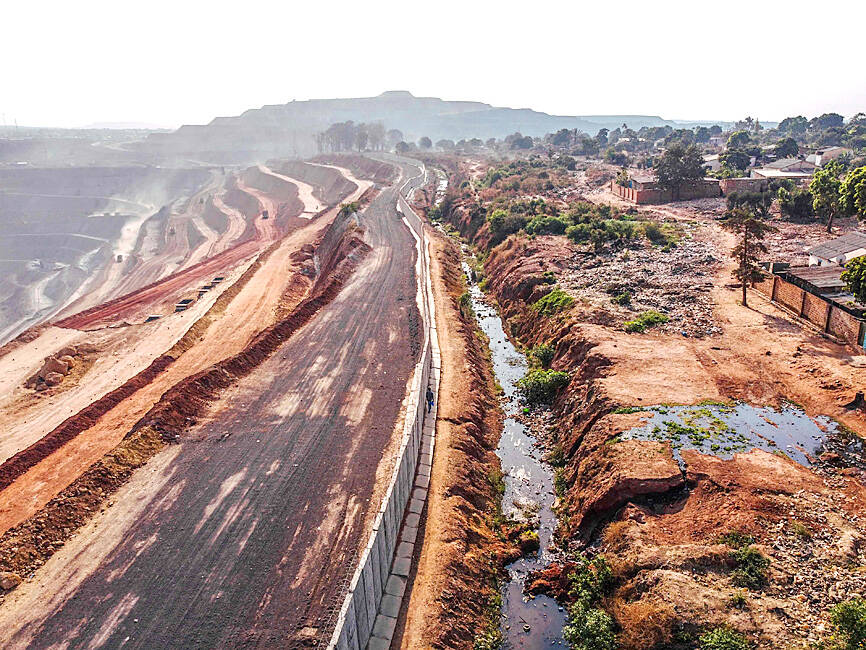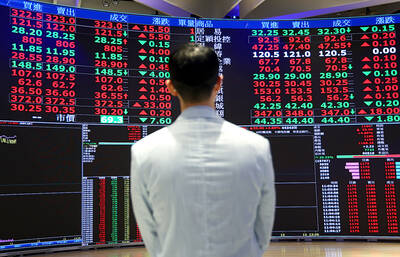“We’re screwed,” said Alphonse Fwamba Mutombo, standing on a plot of rubble overlooking an open-cast cobalt mine in Kolwezi, southeastern Democratic Republic of the Congo (DR Congo). His had once been a thriving neighborhood of neat houses and tree-shaded avenues. Today his cherished home is surrounded by the wreckage of demolished houses, separated from the sprawling pit by a concrete barrier.
The Chinese-owned mine wants to expand, and many of Mutombo’s fellow residents have taken buyouts. Mutombo does not want to leave. The 70-year-old is clinging on, hoping to secure a better deal.
“We live on top of minerals,” Mutombo said.

Photo: AFP
Yet he had no delusions about what ultimately awaited his neighborhood.
“It will disappear,” he said.
Kolwezi, home to more than 500,000 people, sits atop some of the world’s richest mineral reserves — a treasure trove of copper, cobalt and gold that provides the motor for the DR Congo’s economy.
The city is already ringed by a moat of industrial mines, a sandy moonscape of enormous open pits, access roads and pylons.
However, mining activity is increasingly edging inside the city itself, uprooting thousands of people who often complain of unfair treatment. Mining permits cover most of Kolwezi’s surface area, according to the DR Congo’s mining cadastre.
Kolwezi was founded in 1937 by the then-Belgian Congo’s mining monopoly.
Seven years after independence in 1960, the monopoly was nationalized, eventually becoming a giant called the Generale des Carrieres et des Mines, or Gecamines.
As mining in Kolwezi flourished in the subsequent years, the parastatal built neighborhoods such as Mutombo’s Quartier Gecamines Kolwezi for its workers.
Gecamines’ production collapsed in the 1990s after decades of mismanagement, but many of the neighborhood’s remaining residents still have ties to the firm.
“Everyone’s gone, we’re the ones who are left,” said Martin Tino Kolpy Kapenda, a retired Gecamines employee, standing on the plot of what was once his neighbor’s house.
Kapenda, 60, also wants more money from Compagnie Miniere de Musonoi (COMMUS), a Chinese-controlled firm that owns the adjacent copper-cobalt mine.
Some of the remaining residents fear the money on offer would not allow them to find similar-quality housing elsewhere.
Their district has reliable electricity and running water, a rarity in the DR Congo. About 2,000 people out of 38,000 have left the neighborhood within the past six months, city figures showed.
An official in the city administration, who spoke on condition of anonymity, said the entire district could disappear within three years.
COMMUS is offering residents US$7,500 to leave, the official said, although many of the remaining residents are asking for at least three times that amount.
A semi-abandoned housing estate several kilometers outside of Kolwezi has served as a warning to some about enticements offered to leave neighborhoods opened up for mining.
Luzanga Muteba, 78, accepted an offer in 2017 from Chinese-owned firm Congo Dongfang International Mining (CDM) to leave his native Kasulo district. A portion of that neighborhood was razed to make way for a cobalt mine. In surrounding houses, many residents have taken to digging in their gardens for minerals themselves.
CDM built 21 houses for displaced Kasulo residents, but they say the firm never finished the work.
Muteba, wearing an oversized pinstriped shirt, said he once had a thriving bakery in Kasulo, but cannot replicate the business in his new location, which is relatively isolated.
There is also no running water or electricity, although pylons carrying power to nearby mines stretch over the housing estate. Only a few of the houses are now inhabited.
“They have to come and finish the work,” said Muteba, pointing to fetid green puddles in a ravine, where he and other residents draw their water.
“They take our minerals and develop their country,” he said, adding that he was losing hope after petitioning the government several times, without success.
“I wait only for death,” Muteba said.
Shanghai-based Zhejiang Huayou Cobalt Co Ltd (浙江華友鈷業), which owns majority stakes in both COMMUS and CDM, did not respond to questions.
A senior figure in the local government, who asked for anonymity, said he thought it was “inevitable” that Kolwezi would one day disappear under expanding mines.
“This is the mess we live in,” said the official, with a sad smile.

Shares in Taiwan closed at a new high yesterday, the first trading day of the new year, as contract chipmaker Taiwan Semiconductor Manufacturing Co (TSMC, 台積電) continued to break records amid an artificial intelligence (AI) boom, dealers said. The TAIEX closed up 386.21 points, or 1.33 percent, at 29,349.81, with turnover totaling NT$648.844 billion (US$20.65 billion). “Judging from a stronger Taiwan dollar against the US dollar, I think foreign institutional investors returned from the holidays and brought funds into the local market,” Concord Securities Co (康和證券) analyst Kerry Huang (黃志祺) said. “Foreign investors just rebuilt their positions with TSMC as their top target,

REVENUE PERFORMANCE: Cloud and network products, and electronic components saw strong increases, while smart consumer electronics and computing products fell Hon Hai Precision Industry Co (鴻海精密) yesterday posted 26.51 percent quarterly growth in revenue for last quarter to NT$2.6 trillion (US$82.44 billion), the strongest on record for the period and above expectations, but the company forecast a slight revenue dip this quarter due to seasonal factors. On an annual basis, revenue last quarter grew 22.07 percent, the company said. Analysts on average estimated about NT$2.4 trillion increase. Hon Hai, which assembles servers for Nvidia Corp and iPhones for Apple Inc, is expanding its capacity in the US, adding artificial intelligence (AI) server production in Wisconsin and Texas, where it operates established campuses. This

Nvidia Corp chief executive officer Jensen Huang (黃仁勳) on Monday introduced the company’s latest supercomputer platform, featuring six new chips made by Taiwan Semiconductor Manufacturing Co (TSMC, 台積電), saying that it is now “in full production.” “If Vera Rubin is going to be in time for this year, it must be in production by now, and so, today I can tell you that Vera Rubin is in full production,” Huang said during his keynote speech at CES in Las Vegas. The rollout of six concurrent chips for Vera Rubin — the company’s next-generation artificial intelligence (AI) computing platform — marks a strategic

US President Donald Trump on Friday blocked US photonics firm HieFo Corp’s US$3 million acquisition of assets in New Jersey-based aerospace and defense specialist Emcore Corp, citing national security and China-related concerns. In an order released by the White House, Trump said HieFo was “controlled by a citizen of the People’s Republic of China” and that its 2024 acquisition of Emcore’s businesses led the US president to believe that it might “take action that threatens to impair the national security of the United States.” The order did not name the person or detail Trump’s concerns. “The Transaction is hereby prohibited,”